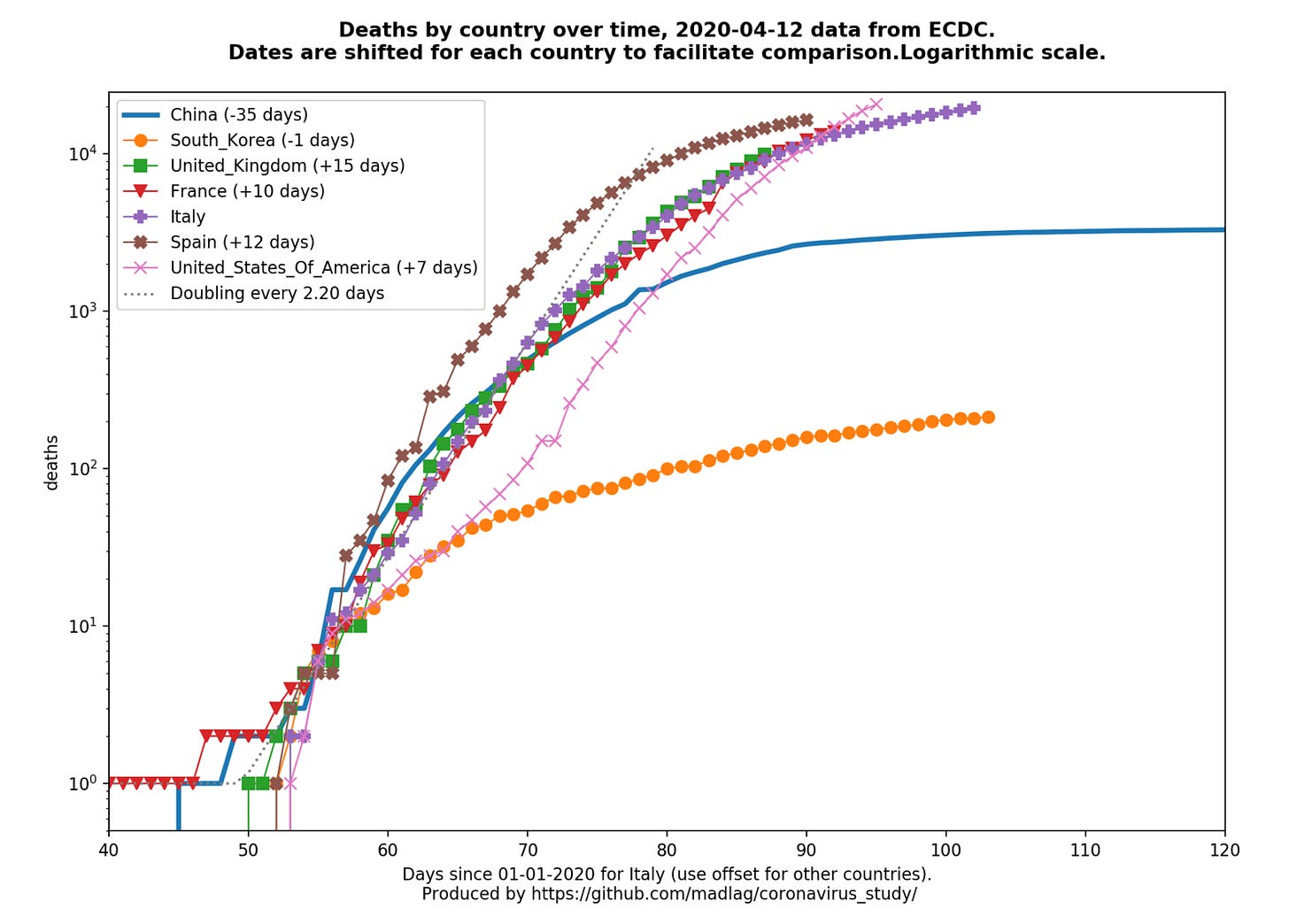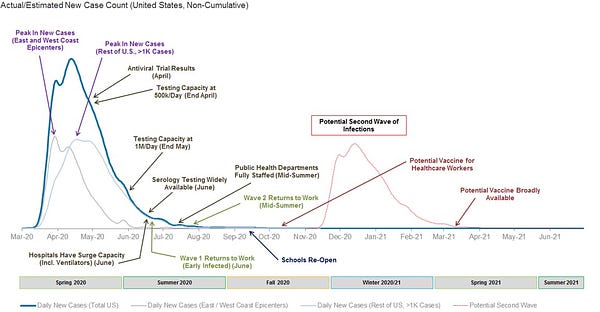🦠 COVID-19 | Urgency should not trump Democracy | 🤕 1,862,254 | Deaths 114,980
I am a scientist by education, banker at JPMorgan for a few years, then mature PhD student in Chemical Biology at Oxford under the supervision of Christofer Schofield (FRS) and Peter Ratcliffe (Nobel laureate in medicine in 2019). Founder and tech investor focusing on media and education. I care about science, learning and Democracy which are good bedfellows.
📊 Daily Data Brief:
1,862,254 cumulative cases (+71,230)
Active cases: 1,315,608 (+43,816) (this is the number of currently infected patients)
Total Deaths: 114,980 (+5,316)
Serious/Critical Cases: 50,884 (+339)
Recovered: 431,666 (+22,098)
Source: Worldometers
Death curves (updated daily as ECDC releases). Major update with per country graphs now available (Link)

Have you seen any meaningful contribution from the opposition to the urgent needed Democratic debate on what is to come: from ending decently the current lockdown (see “Are the food banks coming?” past edition of the Corona Daily) to the plans to reopen the economy (see “Waiting for the vaccine” past edition of the Corona Daily).
It is common feature in times of crisis. Rally behind the leader, see how you can be useful. It is all about action. There is no time for thinking or for being political which is often equated to either being unpatriotic or partisan.
In reality, we do not have such binary choice, and the opposition in Democratic States (until we find better governance) need to play their role. Parliaments need to be recalled and the opposition needs to play a critical role so as not to drift permanently towards Asian form of accepted (for now) authoritarianism and surveillance. They need to look at the future in two phases: the immediate pandemic phase and the future post pandemic-phase. It can still scrutinise the immediate, but can help legislate now for the after the pandemic.
Democratic debate and scrutiny needs to happen, and any urgent decision taken with either debatable efficiency or imperfect data needs to be accompanied by a process for reviewing it or a commitment now to build a more resilient and preferable outcome later.
We cannot let COVID19 lead to more surveillance, authoritarianism and misallocation of ressources the same way 9/11 has. For example, when looking at the question of immunity passports, there is no reason for governments not to commit now to fund a decentralised identity infrastructure post the current emergency in exchange for getting Democratic support now for an imperfect implementation. Apple and Google have shown that for reasons which might go beyond contact tracing, it is possible to be innovative and cooperative to put more privacy at what now seems like the inevitable emergence of contact tracing apps. Equally, Europe should look at whether they are happy to be dependent on two US led operating systems or whether there is a way to fund a third way.
The EU has historically led on privacy, in part due to its dark history, the same way Asia has led on COVID19 thanks to its experience with SARS. When trillions of dollars are spent to emerge out of the crisis, the EU should not miss the opportunity to fund a technology infrastructure that is more aligned with its values. It has the benefit of not having large home grown tech giants to lobby against it.
P.S. three video in the video section below
Article of the day: John Micklethwait (Editor-in-Chief for Bloomberg News) and Adrian Wooldridge (Political editor of The Economist) write “The Virus Should Wake Up the West” with an equally important subtitle:
The job of government is to protect its citizens. The pandemic reveals that key institutions in Europe and the U.S. are no longer up to the job.
The two have a history at looking at modernising the state as they co-authored in 2014 a book titled “The Fourth Revolution: The Global Race to Reinvent the State”.
It obviously starts with Hobbes and his “Leviathan” (the name he gave to an autocratic monarch or state) to whom “citizens should contractually give up their freedoms” in exchange for protection. The article also points that at the time of “Leviathan” China was the modern state and Europe was spending its time bloodstaining itself with incessant feudal rivalries. The authors initially claim that we have now come full-circle with COVID19 as it appears that Singapore and South Korea are safer than New York or London.
They are nevertheless quick to point out that Germany and Denmark (both currently led by women) might be safer than Beijing, Seoul, New York and London without succumbing to authoritarianism or state surveillance (the two generally going together). Maybe these two EU countries are pointing to a third way between “liberal efficiency” and centralised authoritarianism.
The authors take us through history and revolutions since Hobbes with the emergence of the welfare state to its recent dismantling in the 1980s by Reagan and Thatcher with the academic ideological support of the libertarian economists Hayek and Friedman. The authors make their belief clear:
“Behind the ideological squabbling, the main problem with Western government is simple: It is out of date.”
Apart from then lauding the state reinvention in Asian countries in their different ways whilst also identifying their obvious shortcomings, the authors do not offer a third way. They are nonetheless quite unambiguous in chastising China for its concealment:
“It would be an understatement to say that the dark side of its government played a signal role in landing the world in its current mess.”
Undoubtedly, COVID19 has exposed the limits of “liberal efficiency” which neo-liberalism uses as its only guide. However the virus has also exposed 1) the inequalities of fatalities depending on your ranking in society (which is now blindly obvious to the whole of society) and 2) the unhealthy supply-chain dependencies that liberal efficiency builds with unsavoury regimes.
A great read to give historical context to the current pandemic and the need for reinvention of the State, or perhaps more generally governance, in the West and potentially with the EU leading. (Link)
Tweet of the day: Robin Wigglesworth (Global finance correspondent for the Financial Times) tweets a graph from a Morgan Stanley report visualising what an exit plan from lockdown looks like. It depicts what most of the four reopening plans (section below) advocate. Three things to note:
Even at the rate of 1 million/day test capacity it takes 328 days to test the whole US population,
Look at how long it took to get to this capacity on RT-PCR tests and how long we will need to get to this level of testing on anti-body tests. The picture says “Serology test widely available (June)”, without giving a number to define what it means by “widely”,
There are also no numbers on the Y axis on for new cases.


The whole twitter thread of Wigglesworth is also worth reading in particular the excerpt from the Morgan Stanley report:
“This view on the delayed peak and the slow return to work has led our US economists to revise their US forecast to a return to pre-COVID19 levels not until 4Q21”
(Twitter Thread Link)
🦠 Marc Lipsitch (professor in the Departments of Epidemiology and Immunology and Infectious Diseases at Harvard T.H. Chan School of Public Health) writes: “Who Is Immune to the Coronavirus?”. This is great review from Lipsitch about what we know about immunity from coronaviruses and what we have learned about COVID19. Lipsitch advocates that policy makers create a model for decision making when they only have access to imperfect data.
Whilst it is a sensible approach, it should be acceptable only if such exercise is put through a Democratic debate. Given that it will take some time before we can implement immunity certificates (as the level of antibody testing is not up to the task now), we have ample time for this debate to occur.
This is a modified version of “herd immunity”, at a later stage in the epidemic and with less imperfect data. “Take it on the chin” did not go down so well for some the first time around. (Link)
🚔 Kathryn Olivarius (Assistant professor of history at Stanford University) writes “The Dangerous History of Immunoprivilege” for the New York Times. The immunity passports are coming or so everyone says. Every one except the civil liberties and privacy advocates. They are now joined by an historian in questioning how sound COVID19 certificates are to bring the world economy back to life. Olivarius draws on how “immunoprivilege” was used during the yellow fever epidemic in the US Deep South in the 19th century, and how it entrenched inequalities. As noted above, the inequalities in infection rate and outcome of diseases for COVID19 depending on your social standing or race are becoming abundantly clear. As Olivarius writes in relation to immunoprivileges :
“The most vulnerable people in our society cannot be punished twice over: first by their circumstance and then by the disease. We have been here before and we do not want to go back.”
History is always important (and historically overlooked) in planning a better future. (Link)
👨⚕️ Michael Specter writes “How Anthony Fauci Became America’s Doctor” for The New Yorker. Anthony Fauci who is the lead doctor (to say the least) in Trump task force finally gives us his philosophical reference in handling Trump and other leaders when dealing with an epidemic (and before COVID19, he was involved in some leadership role for H.I.V., SARS, avian influenza, swine flu, Zika, and Ebola). So here it is:
“I go to my favorite book of philosophy, ‘The Godfather,’ and say, ‘It’s nothing personal, it’s strictly business. ”
Pure philosophical genius. America is lucky to have Fauci. Great read on a great man. (Link)
🚔 Ross Anderson (Professor of Security Engineering at Cambridge University) writes “Contact Tracing in the Real World”. This is a no nonsense and clear article looking at the pros and cons of Bluetooth based contact tracing. Anderson is somewhat dubious about their efficacy and believes it is more government play-acting:
“All that said, I suspect the tracing apps are really just do-something-itis. Most countries now seem past the point where contact tracing is a high priority; even Singapore has had to go into lockdown. If it becomes a priority during the second wave, we will need a lot more contact tracers: last week, 999 calls in Cambridge had a 40-minute wait and it took ambulances six hours to arrive. We cannot field an app that will cause more worried well people to phone 999.”
A complex issue particularly on how and how long contact tracing should be implemented. Must read for all of us as contact-tracing is gathering steam post Google-Apple partnership. (Link)
Reopening plans (NEW❗️): The Corona Daily had previously featured the American Enterprise Institute reopening plan. You can find it below along with the there other cited by Ezra Klein article in Vox.
The left-leaning Center for American Progress wrote“A National and State Plan To End the Coronavirus Crisis” (Link)
Harvard University’s Safra Center for Ethics wrote “When can we go out?” (Link)
Nobel Prize-winning economist Paul Romer (Link)
The Conservative-leaningAmerican Enterprise Institute wrote the previously featured: “National coronavirus response: A road map to reopening” (Link)
Literary Joy: Clever, fun and as JP Rangaswami who alerted me to it: “bringing a little bit of literary joy into our lives during dark and sombre times for many.”
🎬 Video of the day:
When thinking about allocation of stimulus money, Chamath Palihapitiya makes a good point to preserve social cohesion:
Andrea Bocelli's 'Music for Hope' Easter concert streams from empty Duomo di Milano. Bocelli opened the concert by the following words
“On the day we celebrate the trust in a life that triumphs, I'm honored and happy to answer 'si'. Thanks to music, streamed live, bringing together millions of clasped hands everywhere in the world, we will hug this wounded Earth's pulsing heart."
Stunning performance accompanied by images of empty cities around the world (Link)
Boris Johnson “NHS saved my life” speech as the Prime Minister leaves hospital to check-in at Chequers to recover:
📊 A picture is worth a thousand words: Global (🌎) and local (with relevant flag) visualisation and forecasting tool
🌍
NEW❗️MRC Centre for Global Infectious Disease Analysis started to publish weekly death estimates for countries (Link)🇺🇸
NEW❗️The US Center for Disease Control and Surveillance (CDC) publishes “A Weekly Surveillance Summary of U.S. COVID-19 Activity” (Link)Google has published a new website to “See how your community is moving around differently due to COVID-19”. They have a lot of data to do so… (Link)
🌎The Financial Times has a data tracking page which is in front of the paywall, looking at cases and fatality curves for selective countries and metropolitan areas/region. It is not as extensive as the Madlag link below, where you can see static as well as animated images for a greater number of individual countries. (Link)🇺🇸/🌍The Institute for Health Metrics and Evaluation (IHME) is an independent global health research center at the University of Washington (UW). It has put out a simulation for the US (overall and by state) of what is the expected shortfall in health capacity (bed, ICU, ventilators) and when is the expected peak of the epidemic for each state. It has now added countries in the European Economic Area (EEA). A valuable resource. (Link)🇺🇸Another valuable resource by Unacast ( a data company providing human mobility insights). Their “Social distancing scoreboard looks and compares (State by State and County by County), the change in mobility to prior to COVID19 (Link)
🌎 Country by Country Curves: This is a GitHub made by my friend Francois Lagunas. He has written a script to scrape deaths and number of cases in order to visualise the rate of growth on a logarithmic scale. Great resource (Link)
CityMapper has started to produce City Mobility Index to show how much a City is moving. This is a very good indicator of how well lockdowns are respected around the world: Barcelona (4% of city moving) at one end and St Petersburg at the other end (68% of city moving) for yesterday (Link)
🌎A great resource put together by Ben Kuhn and Yuri Vishnevsky. At a time when we need solidarity and cooperation, I prefer their subtitle “We need stronger measures, much faster” than their title. It’s a simulator on what case growth looks like depending on your community’s measures. Fantastic resource to stir communities and governments to action (Link)
🇩🇪 The COVID19 dashboard for Germany is one of the best around. (Link)
🌎A helpful guide by VOX of the “9 coronavirus pandemic charts everyone should see” (Link)
🌎Data and chart regularly updated by the Centre for the Mathematical Modelling of Infectious Diseases at the London School of Hygiene & Tropical Medicine. It maps the effective reproduction number (also known as R0) of COVID19. You want to get it below 1 as fast as possible to contain an epidemic. (Link to see charts and more data about your country)
🌎This is a great COVID19 Dashboard prepared by Andrzej Leszkiewicz. Andrzej has also written an introductory and explanatory blog for it (“Coronavirus disease (COVID-19) fatality rate: WHO and media vs logic and mathematics”). I particularly like the country comparison tab, which allows you to track and benchmark the curve of the epidemic (number of cases and deaths) in your country with that of another. Very well done and informative. (Link)
“Going Critical” by Kevin Simler is a detailed interacting essay talking about complex systems, the importance of understanding networks, modelling and how this applies to: memes, infectious diseases, herd immunity, wildfire, neutrons and culture. Must read (Link)
🇸🇬/🌎 Singapore remains the gold standard of dashboard. Here is an article with the Best and Worst of all dashboard in the world, with Pros and Cons prepared by Neel V. Patel for MIT Technology (Article)
🏛 Notable tracking projects
💊“COVID-19 treatment and vaccine tracker”. This tracker contains an aggregation of publicly-available information from validated sourcesby the Milken Institute (Link)🏛Tariq Krim has started a COVID19 website tracking data about each government policy response to the pandemic (Link)
🏛Oxford COVID-19 Government Response Tracker (OxCGRT) was launched yesterday. Data is collected from public sources by a team of dozens of Oxford University students and staff from every part of the world. It also looks at stringency of the measures and plots stringency with case curves. A great initiative and resource (Link)
👩💻Mike Butcher (Editor at Large Techcrunch and founder of TechforUK), had refocused TechforUK on the fight against COVID19. It is a very effective hands-on team of volunteer. Do reach out to them. He has also teamed up with We are now working closely with the volunteers behind the “Coronavirus Tech Handbook”. (They are ‘cousins’ of ours who originally created the Electiontechhandbook). Volunteer collaboration at its best! (Link)
📰 Cronycle resource:
Cronycle has made available a number of open-access feeds on its website which I extensively use for the Corona Daily. The four first feeds are:
1. COVID-19 General (Link)
2. COVID-19 x Resilience (Link)
3. COVID-19 x HCQ/CQ (Link) (HydroxyChloroquine and Chloroquine)
4. Gig Economy x COVID-19 (Link)
And I have added a new feed below
5. Supply Chain x COVID-19 (Link)
I will write more in the future on how you can leverage Cronycle for keeping up to date in between two editions of this newsletter. (Link)
Here is a blog post from Valerie Pegon at Cronycle: “Grow knowledge about Covid-19, not anxiety!” (Link)
🎬 The Grant Sanderson permanent video corner:
Exponential growth and epidemics
This is an excellent video explaining “exponential growth” and epidemics. Although we are all familiar with the phrase, its authors rightly says that “yet human intuition has a hard time recognising what it means”. This is a ❗️MUST WATCH❗️to understand fully what is upon us but also how early behavioural changes at scale can have a massive impact on the level of exponential growth of COVID19 (Link)
“Simulating an Epidemic”
This is the second video by Grant Sanderson looking at simulating an epidemic under different physical distancing measures. (Link)







